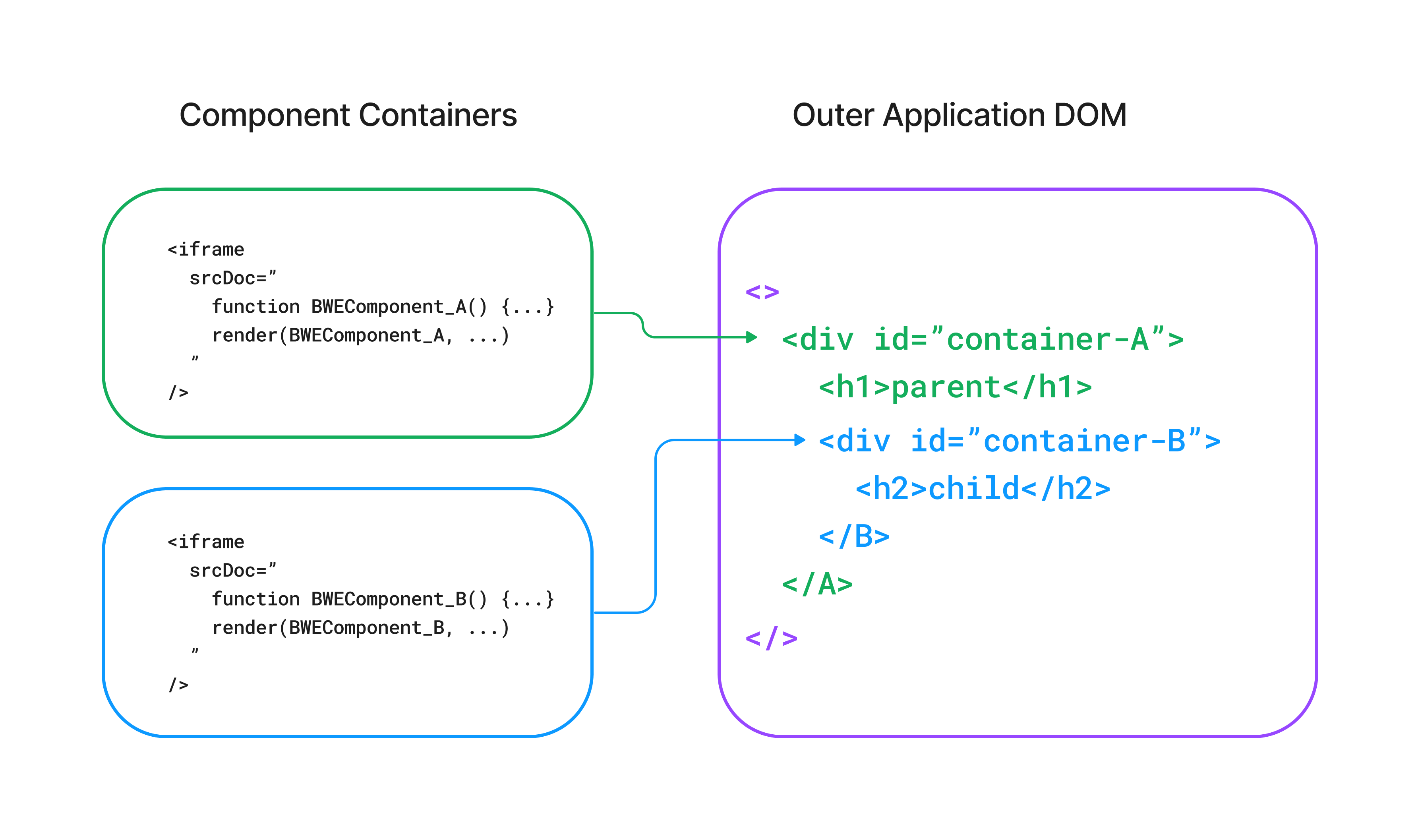Architecture
BOS Component Loading
BOS Components are loaded in BOS Web Engine by way of a client-side pipeline, responsible for BOS Component source fetching, TSX transpilation, and Component composition. A web worker services requests from the outer application to load new Components, caching the Component source and transpiled wrapper function. The worker responds with the wrapped source code, which is used to initialize containers with iframes.
 High-level overview of the flow from BOS Component source to Component container.
High-level overview of the flow from BOS Component source to Component container.
Component Containers
Containers are abstractions around sandboxed iframes, responsible for managing the lifecycle of a single root Component.
The outer application renders a container for each root Component, rendering the container's hidden iframe and executing
the container code in the iframe's srcDoc field.
Containers rely on Preact for Component lifecycle management. When a Component has updated, options hooks set in Preact serialize the rendered node and send it to the outer application. The initial render request is explicitly triggered upon container initialization. This Preact integration enables the use of React hooks within BOS Components.
Interactions between containers are facilitated by the iframe parent's window object, e.g. window.parent.postMessage().
The outer application and individual containers register event handlers on this window object to facilitate bidirectional
message passing to communicate renders and broker inter-Component callbacks. As a consequence of this, all inter-Component
communication is inherently asynchronous.

Component containers manage root Components, which may be under another Component in the DOM tree despite being sandboxed.
Trust
Component Trust ensures that BOS Components retain control over composability with other Components. When rendering a BOS Component in Web Engine, the trust mode determines how to load the Component:
- trusted loads the Component inside the same container
- sandboxed loads the Component as a root Component in a new container
Trust mode does not impact the rendered output in the outer application, but has implications for performance and security. In particular:
- Trusted Components invoke methods directly within the same context. Sandboxed Components are subject to performance overhead inherent in proxying callbacks through the outer application.
- Sandboxed Components are loaded dynamically, and their paths do not need to be known at build time. Trusted Components incur a loading penalty upfront when fetching and parsing source for multiple Components, and must use statically-analyzable paths to guarantee all Components are known at build time.
- Sandboxed Components run in their own sandboxed iframe container and may only communicate with other containers using a well-defined message passing interface. Trusted Component trees run in the same context, with access to the same references.
Component Trust is best employed to create logical trust boundaries in a BOS application, for instance between Components from different accounts. By default, BOS Components are loaded as sandboxed; loading a Component as trusted requires explicit configuration.
 Trusted Components are included in the same container context as their parent Component.
Trusted Components are included in the same container context as their parent Component.
Component Callbacks
Callbacks between Components (e.g. functions passed via props) are supported in BOS Web Engine, though the exact behavior is
dependent on whether the Components are within the same container. Callbacks between two Components in the same container
work without constraints, but there are caveats for callbacks between containers as the caller and callee exist in completely
independent contexts. Under the hood, these inter-container callbacks must be invoked (and return data) using the message passing interface
provided by window.postMessage, and are subject to some constraints accordingly:
- Arguments may only use types compatible with the structured clone algorithm.
While functions cannot be provided as arguments directly, references to callbacks in other containers may be passed, allowing
BOS Components to invoke functions on
propswith function arguments. - Inter-container callbacks are inherently asynchronous, for which a Promise-based interface is provided to abstract away the underlying event-based communication.